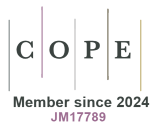Most read articles by the same author(s)
- Antonio Costanzo, Gianluca Furneri, Rossella Bitonti, Maria Paola Pedone, Francesca Fanelli, Roberta Di Turi, Cost-effectiveness analysis of dupilumab for the treatment of severe atopic dermatitis in adults in Italy , Global and Regional Health Technology Assessment: Vol. 7 No. 1 (2020): January-December 2020
- Claudio Jommi, Filippo Cipriani, Francesca Fanelli, Maria Paola Pedone, Walter Canonica, The effects of disease cross-coverage by dupilumab on the costs sustained by the Italian National Health Service , Global and Regional Health Technology Assessment: Vol. 7 No. 1 (2020): January-December 2020
- Claudio Jommi, Giovanni Apolone, Giovanna Scroccaro, Valentina Acciai, Antonio Addis, Andrea Ardizzoni, Renato Bernardini, Alberto Bortolami, Alessia Brigido, Giuliano Buzzetti, Pier Luigi Canonico, Francesca Caprari, Stefano Centanni, Chiara Cernetti, Americo Cicchetti, Giorgio Corsico, Francesco Damele, Filippo De Braud, Sara Manurita, Francesco Saverio Mennini, Irene Olivi, Federica Parretta, Lara Pippo, Stefania Pulimeno, Massimo Riccaboni, Giuseppe Rossi, Cecilia Saleri, Alessandra Sinibaldi, Federico Spandonaro, Cristian Stefenoni, Elena Visentin, Pierluigi Viale, Giuseppina Zapparelli, Patrizia Popoli, Drugs price and reimbursement regulation: comparators, endpoints and role of the cost-effectiveness , Global and Regional Health Technology Assessment: Vol. 9 No. 1 (2022): January-December 2022
- Giovanni Corrao, Giovanni Alquati, Giovanni Apolone, Andrea Ardizzoni, Giuliano Buzzetti, Giorgio W. Canonica, Pierfranco Conte, Elisa Crovato, Francesco Damele, Carlo La Vecchia, Aldo P. Maggioni, Alberto Mantovani, Michele Marangi, Walter Marrocco, Andrea Messori, Alessandro Padovani, Alessandro Rambaldi, Walter Ricciardi, Francesco Ripa di Meana, Federico Spandonaro, Valeria Tozzi, Giuseppe Mancia, Real-world data: how they can help to improve quality of care , Global and Regional Health Technology Assessment: Vol. 8 No. 1 (2021): January-December 2021
- Sanja Stanisic, Americo Cicchetti, Camillo Porta, Giuseppe Procopio, Patrizia Berto, Cost-effectiveness of cabozantinib in second-line treatment of metastatic renal cell cancer (mRCC) in Italy , Global and Regional Health Technology Assessment: Vol. 5 No. 1 (2018): January-December 2018
- Sanja Stanisic, Antonio Bertolotto, Patrizia Berto, Paolo Di Procolo, Julia Morawski, The cost-effectiveness of alemtuzumab in the management of relapse-remitting multiple sclerosis in Italy , Global and Regional Health Technology Assessment: Vol. 6 No. 1 (2019): January-December 2019
- Elena P. Lanati, Paola La Malfa, Arianna Iorio, Francesco S. Mennini, Francesca Fanelli, Sandro Gentile, Budget impact analysis of different rapid-acting insulin analogues in Italy , Global and Regional Health Technology Assessment: Vol. 5 No. 1 (2018): January-December 2018
- Sanja Stanisic, Alessia Marocco, Anna Gallo, Paolo Rama, Marta Sacchetti, Maurizio Rolando, Augusto Pocobelli, Roberto Ceccuzzi, Andrea Leonardi, Rita Mencucci, Emilio Pedrotti, Elisa Postorino, Maurizio Mascia, Lucia R Mazzamuto, Luisanna Prisco, Floortje Van Nooten, Patrizia Berto, Epidemiology and economic impact of moderate and severe neurotrophic keratopathy in Italy , Global and Regional Health Technology Assessment: Vol. 5 No. 1 (2018): January-December 2018
- Patrizia Popoli, Walter Marrocco, Anna Ponzianelli, Francesco Damele, Massimo Medaglia, From Regulatory framework to practice: the EU HTA Regulation 2021/2282, AIFA role and interactions with developers: processes, interfaces, expectations , Global and Regional Health Technology Assessment: Vol. 12 No. 1 (2025): January-December 2025









